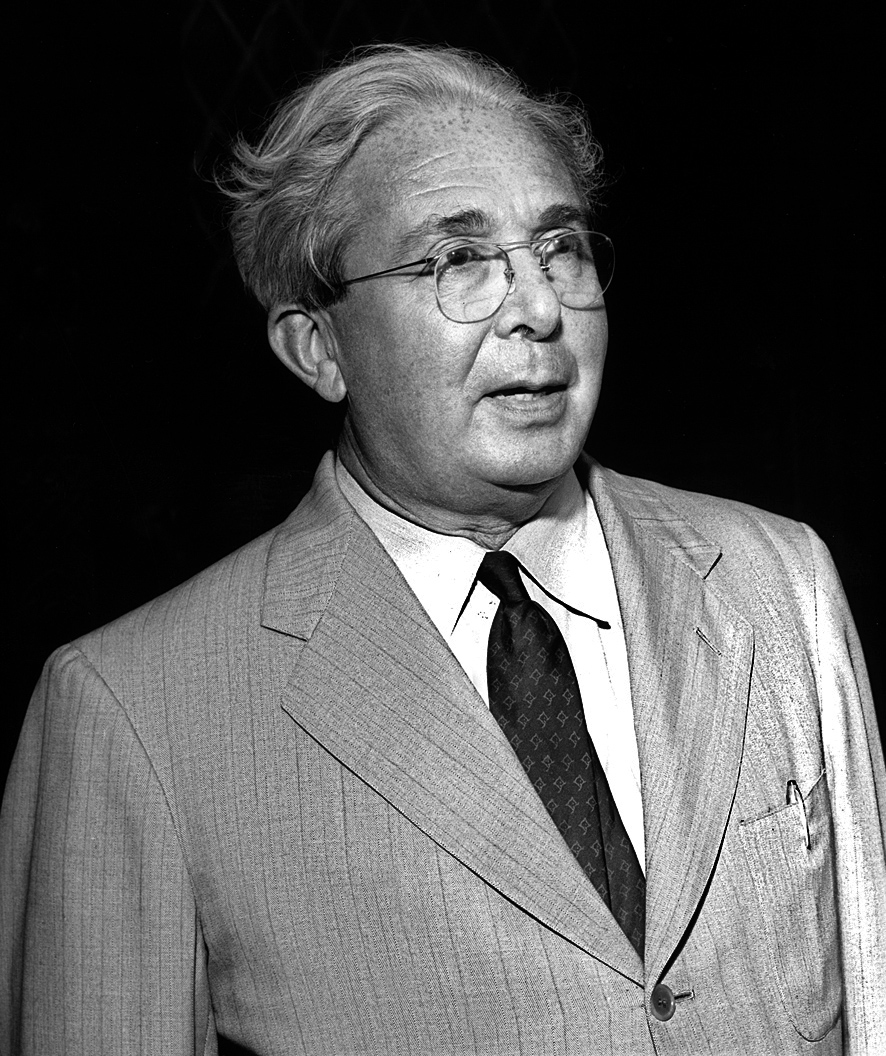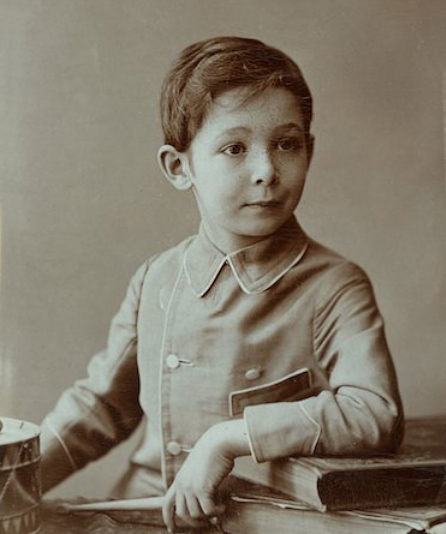|
Early Years
Leo Spitz was born in Budapest Hungary on February
11, 1898 to middle-class Jewish parents, Louis Spitz, a civil engineer,
and Thekla Vidor. He had two younger siblings, a brother, Béla, born
in 1900, and a sister, Rózsi (Rose), born in 1901. On October 4, 1900, the
family changed its surname from the German "Spitz" to the Hungarian "Szilard",
a name that means "solid" in Magyar. Despite having a religious
background, Szilard became an agnostic.
Education
In 1916 Szilard enrolled as an engineering
student at the Palatine Joseph Technical University in Budapest. He also
briefly served in the army and was discharged honorably in November 1918. Convinced that there was no future for
him in Hungary, Szilard left for Berlin on December 25, 1919, and enrolled
at the Technische Hochschule (Institute of Technology) in Berlin-Charlottenburg.
Becoming bored with engineering he switched to physics and transferred
to Friedrich Wilhelm University (University of Berlin) where he attended lectures given by Albert
Einstein, Max Planck, Walter Nernst, James Franck and Max von Laue.
He
also met fellow Hungarian students Eugene Wigner,
John von Neumann and
Dennis Gabor.
His doctoral
dissertation was "The Manifestation
of Thermodynamic Fluctuations",
praised by Einstein, and winning top honors in 1922. It involved a
long-standing puzzle known as
Maxwell's demon. The problem was thought to be insoluble, but in
tackling it Szilard recognized the connection between thermodynamics and
information theory.
Career in Europe
Szilard was appointed as assistant to von
Laue at the Institute for Theoretical Physics in 1924. In 1927 he finished
his
habilitation and became a
Privatdozent (private lecturer) in physics. For his habilitation
lecture, he produced a second paper on Maxwell's Demon, Über die
Entropieverminderung in einem thermodynamischen System bei Eingriffen
intelligenter Wesen (On the reduction of entropy in a thermodynamic
system by the intervention of intelligent beings), that had actually been
written soon after the first. This introduced the thought experiment now
called the
Szilard engine and became important in the history of attempts to
understand Maxwell's demon. The paper is also the first equation of
negative entropy and information. As such, it established Szilard as one
of the founders of information theory, but he did not publish it until
1929, and did not pursue it further. Claude E. Shannon, who took it up in
the 1950s, acknowledged Szilard's paper as his starting point.
Throughout his time in Berlin, Szilard
worked on numerous technical inventions. In 1928 he submitted a patent
application for the linear accelerator, not knowing of Gustav Ising's
prior 1924 journal article and Rolf Widerĝe's operational device, and in
1929 applied for one for the cyclotron. He also conceived the electron
microscope. Between 1926 and 1930, he worked with Einstein to
develop the
Einstein refrigerator, notable because it had no moving parts.
In September, 1933, Szilard read an
article in The Times summarizing a speech given by
Lord Rutherford in which Rutherford rejected the feasibility of using
atomic energy for practical purposes. Szilard was so annoyed at
Rutherford's dismissal that he conceived the idea of the
nuclear chain reaction using recently discovered neutrons.
In early 1934, Szilard began working at
St Bartholomew's Hospital in London studying radioactive isotopes
developing the
SzilardChalmers effect used in the preparation of medical isotopes.
Move to New York
City
In
November, 1938 Szilard moved to New York
City, taking a position at Columbia University. In January
Niels Bohr brought news to New York of the discovery of nuclear
fission in Germany by
Otto
Hahn and
Fritz Strassmann, and its theoretical explanation by
Lise Meitner, and
Otto Frisch. When Szilard found out about it he immediately realized
that uranium might be the element capable of sustaining a chain reaction.
Szilard and Zinn conducted a simple experiment on the seventh floor of
Pupin Hall at Columbia, using a radium-beryllium source to bombard uranium
with neutrons. They discovered significant neutron multiplication in
natural uranium, proving that a chain reaction might be possible. In
collabaration with Enrico Fermi Szilard patented the nuclear reactor which
was latter tested on 2 December 1942 under
Stagg Field at the University
of Cicago.
Letter to President
Roosevelt regarding the Atomic Bomb
Dated August 2, 1939 Szilard drafted a confidential letter to the President
Franklin D. Roosevelt explaining the possibility of nuclear weapons,
warning of German nuclear weapon project, and encouraging the development
of a program that could result in their creation. With the help of fellow
Hungarian friends Eugene Wigner and Edward Teller, he approached his old
friend and collaborator Einstein and convinced him to sign
the letter which resulted in the establishment of research into
nuclear fission by the U.S. government, and ultimately he
Manhattan Project and the atomic bomb. Roosevelt gave the letter to his
aide, Brigadier General Edwin M. "Pa" Watson with the instruction: "Pa,
this requires action!"
Metallurgical
Laboratory in Chicago
In January 1942, Szilard joined the
Metallurgical Laboratory in Chicago and later
became
chief physicist. He also became a United States naturalized citizen
a year later
in March 1943. With a passion for the preservation of human life, Szilard hoped that the U.S. government would not
use nuclear weapons and drafted the Szilard petition advocating
demonstration of the atomic bomb. With the recommendation of J.R.
Openheimer the
Interim Committee instead chose to use atomic bombs against cities
over Szilard and other scientists protests. Later, Szilard lobbied
for amendments to the Atomic Energy Act of 1946 that placed nuclear energy
under civilian control.
After World War II
At the end of WWII Szilard in his late 40s
ended his career in physics and became a microbiologist. In 1946 he secured a research professorship at the University of Chicago that
allowed him to dabble in biology and the social sciences. He teamed up
with
Aaron Novick, a chemist who had worked at the Metallurgical Laboratory
during the war. It was a field that Szilard had been working on in 1933
before he had the quest for a nuclear chain reaction. The duo invented the
chemostat, a device for regulating the growth rate of the bacteria in
a
bioreactor. They also discovered
feedback inhibition, an important factor in processes of growth and
metabolism. Szilard gave essential advice to Theodore Puck and Philip I.
Marcus for their first cloning of a human cell in 1955. Szilard married
Gertrud (Trude) Weiss, M.D., in a civil ceremony in New York on October
13, 1951. Weiss took up a teaching position at the University of Colorado
in April 1950, and Szilard began staying with her in Denver.
His last
years
In 1960, Szilard was diagnosed with bladder
cancer. He underwent cobalt-60 radiation therapy at New York's
Sloan-Kettering Memorial Hospital on a treatment regimen he designed
himself. A second round of treatment with an increased dose followed
in 1962. The doctors tried to tell him that the increased radiation dose
would kill him, but he said it wouldn't, and that anyway he would die
without it. The higher dose resulted in a cure and his cancer never returned.
This treatment became standard for many cancers and is still used.
Szilard helped create he
Salk Institute for Biological Studies in La Jolla (San Diego),
California, where he spent the last year of his life. He was
appointed a non-resident fellow there in July 1963, and became a resident
fellow in April 1, 1964, after moving to La Jolla in February. On May 30,
1964, he died in his sleep of a heart attack. His remains were
cremated and his papers are in the library at the University of California
in San Diego. In February 2014, the library announced funding from the National Historical Publications and Records Commission
to digitize its collection of his papers, extending from 1938 to 1998. |

